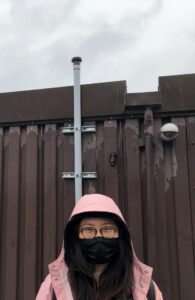November 15, 2021
ARC advances research in lighting for neonatal care
College of Built Environments partners with ZGF Architects and Cincinnati Children’s Hospital Medical Center
Recent research shows that adequate daylight, particularly the violet and blue wavelengths of the visible spectrum, can exert a positive influence on brain and eye development in premature babies. Neonatologists and discovery biologists are therefore seeking to mimic daylight in neonatal care, and to determine which wavelengths, intensity, and duration are most important for supporting womb-like development.
An Applied Research Consortium (ARC) research project led by Zining Cheng, a graduate student in architecture, aims to develop design guidelines for daylighting and electric lighting (i.e., tunable light fixtures) for newborn intensive care units (NICU) that can be understood and used by lighting designers and medical planners.

The spectrophotometer sensor (foreground) on the roof of Gould HallMehlika Inanici
Cheng’s design guidelines will take into account the surface colors and materials in the room (walls, floors, ceilings), and will recommend appropriate window glazing and shading systems to modulate the daylight. The electric lighting system will supplement the daylighting in the room to provide the targeted range of wavelengths and intensities.
The importance of phototherapy for the development of premature infants has been known for several decades. In fact, Cheng herself received phototherapy as a premature infant in the NICU. “However,” she said, “at that time, research had yet to identify specific light wavelengths, and the conventional phototherapy treatment had drawbacks. I know that my parents and other NICU parents would appreciate a better lighting template that enhances newborn development.”

ARC Fellow Zining Cheng on the roof of Gould Hall. The spectrophotometer sensor is mounted on top of the grey pipe directly behind her.Mehlika Inanici
To support this project, the ARC research team installed a spectrophotometer on the roof of Gould Hall last summer. The spectrophotometer measures the variability of sky spectra every minute. Measurements will be used to simulate spectrally accurate NICU settings, with the goal of improving design decisions to better support healthcare architecture.
“Sky spectrophotometry is measured in just a few places around the world, and I’m really excited that the College of Built Environments is one of those places,” said Mehlika Inanici, Associate Professor of Architecture, who serves as faculty advisor for the ARC project.
In addition to Inanici, the research team includes Marty Brennan, daylighting specialist, and Kelly Chanopas, architect and medical planner, from ZGF. The team collaborates with Dr. James Greenberg, Co-Director of the Perinatal Institute at Cincinnati Children’s Hospital Medical Center, and Dr. Richard Lang, Director of the Visual Systems Group, also at Cincinnati Children’s.
Brennan noted, “This is an amazing interdisciplinary opportunity to advance light health in architectural practice using sky data collection, emerging metrics, and open-source computational methods.”
Cheng expects to graduate in Spring 2022 with a MArch and a MS in Architecture, Design Technology program.
